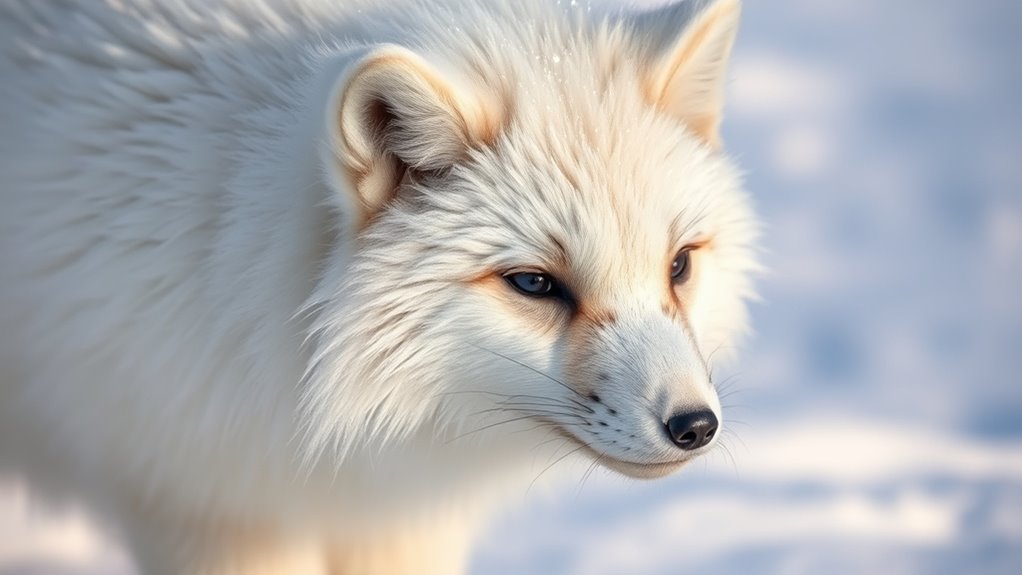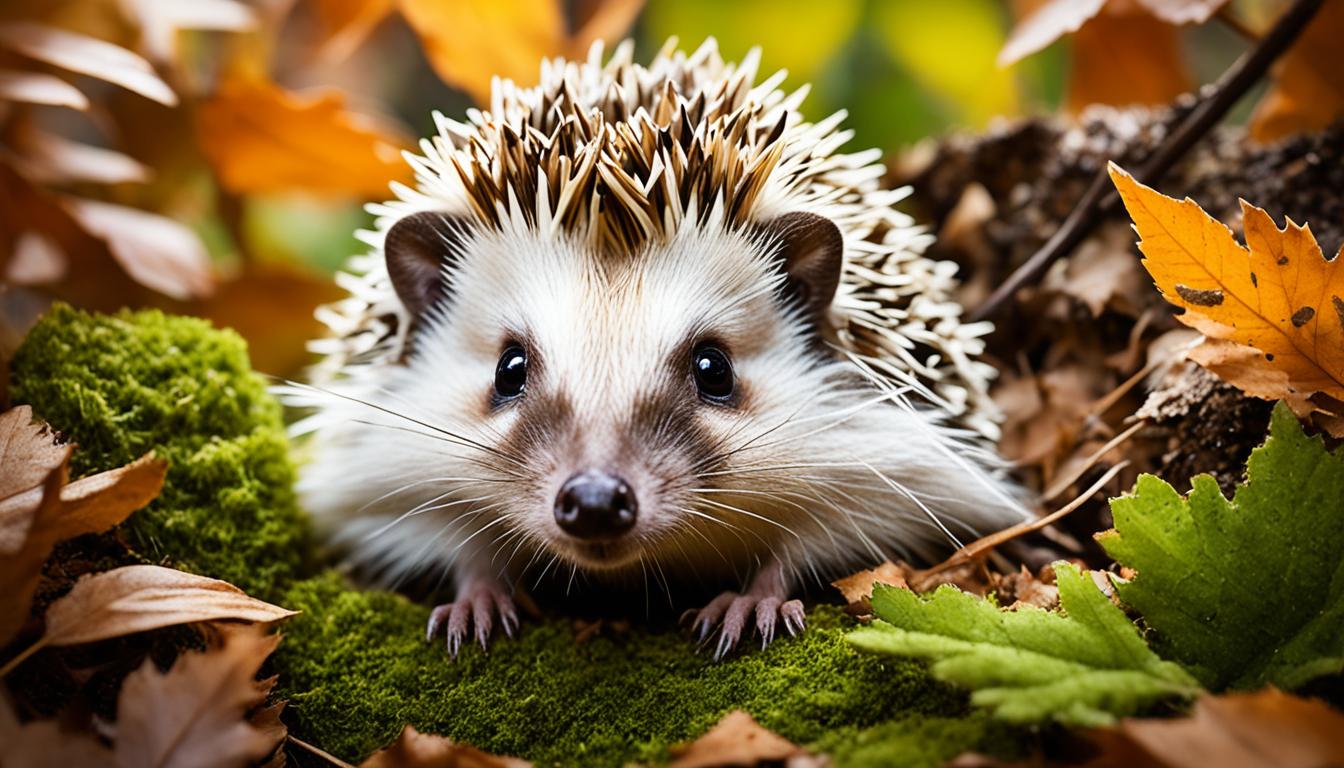Fur plays an essential role in animal insulation, helping species in freezing environments maintain their body heat. It traps air within its layers, which slows heat loss and keeps temperatures stable. Thicker and denser fur is more effective for insulation, allowing animals like polar bears to survive extreme cold. Some mammals even have special adaptations, like blubber for extra warmth. Discover how fur variations influence survival strategies among different species.
Key Takeaways
- Fur acts as an insulator by trapping air within its layers, reducing heat loss in cold environments.
- Thicker and denser fur provides enhanced insulation, crucial for maintaining stable body temperatures in extreme cold.
- Individual hair structures scatter infrared light, minimizing heat loss through radiation.
- Species adaptations in fur thickness and density optimize survival in their specific habitats.
- Some marine mammals utilize blubber alongside fur for additional thermal insulation in aquatic environments.
The Importance of Insulation in Cold Environments
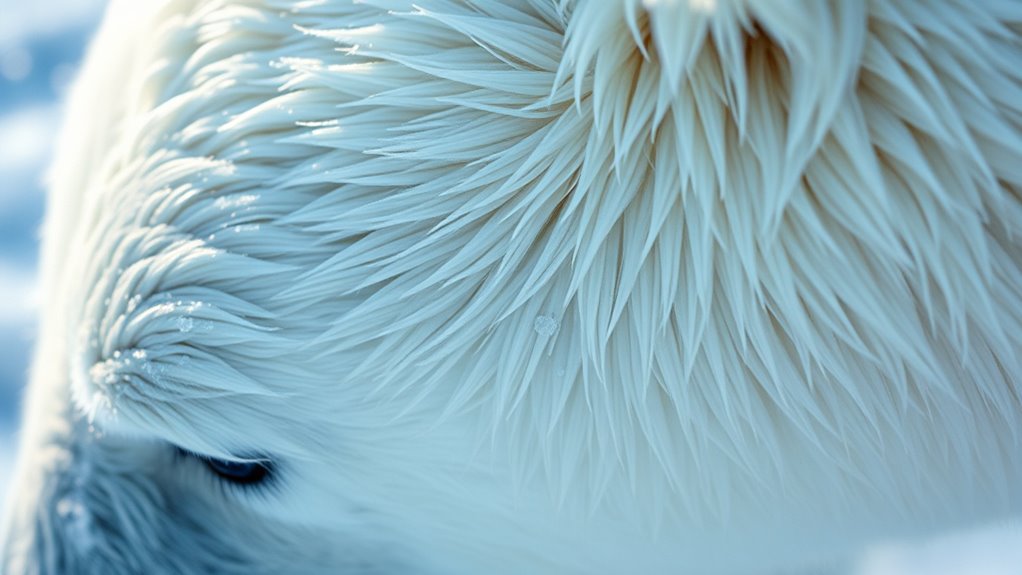
When you think about animals surviving in frigid environments, it's clear that insulation plays an essential role in their survival. Thicker fur, like that found in polar bears, helps them maintain a stable body temperature of 37°C (98.6°F) even when temperatures plummet to -40°C (-40°F).
This dense fur prevents excessive heat loss, which is critical since cooling can slow down biological reactions and impair necessary metabolic processes. In addition to fur, animals like seals rely on layers of blubber for extra thermal insulation, enhancing their ability to thrive in icy waters.
Each species has adaptations tailored to their specific habitat, ensuring they survive the harshest climates by effectively retaining heat and supporting essential functions.
Mechanisms of Heat Retention in Fur
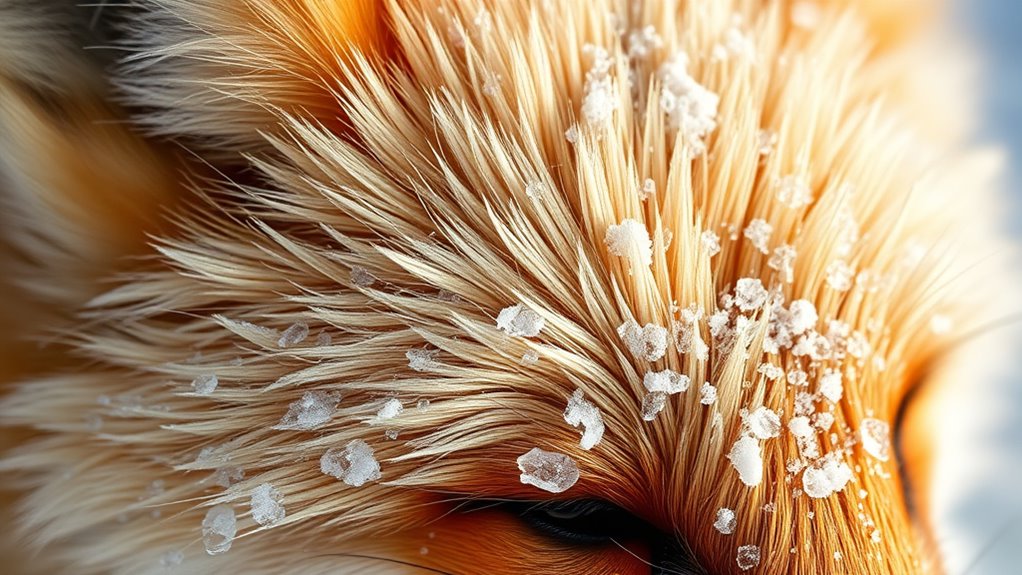
While fur serves as a remarkable insulator for many animals, its effectiveness hinges on several key mechanisms that enhance heat retention. The air trapped within the layers of fur acts as a poor conductor of heat, greatly slowing down heat transfer and minimizing heat loss from the body.
Take polar bears, for instance; their fur, though only 5 cm thick, helps maintain body temperatures of 37°C (98.6°F) in extreme cold. Their underfur retains a thick stagnant layer of water, improving thermal insulation, especially in aquatic environments.
Additionally, the unique structures of individual hairs scatter infrared light, further reducing heat loss through radiation. Overall, animal fur's insulation capabilities can surpass even traditional building materials, highlighting its exceptional heat retention.
Comparative Analysis of Insulation in Different Species
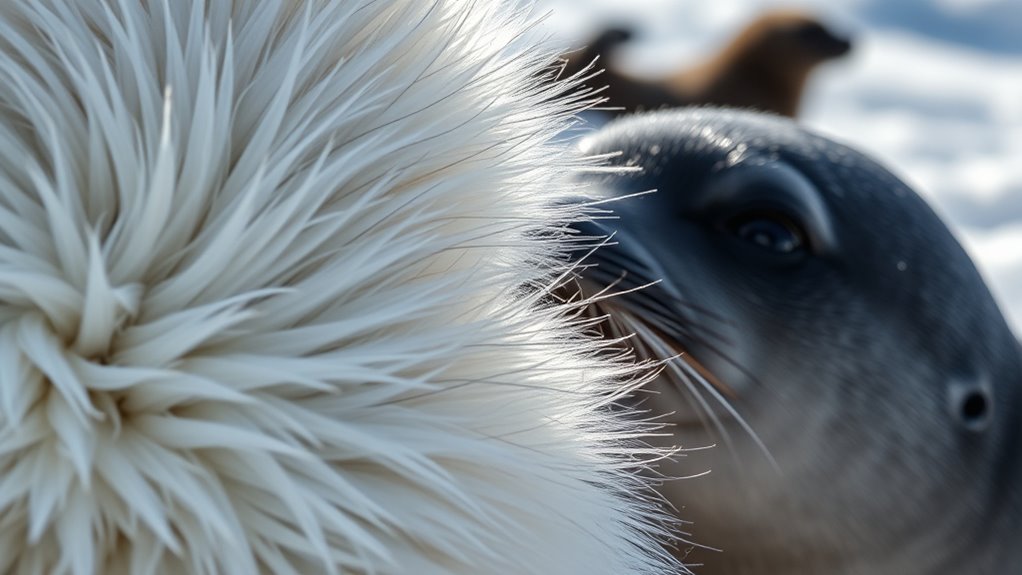
Understanding how different species insulate themselves reveals fascinating adaptations tailored to their environments.
For instance, the polar bear has a remarkable thick layer of fur that, while only 5 cm long, traps air effectively. This design allows them to withstand frigid temperatures as low as -40°C (-40°F) while maintaining a stable body temperature of 37°C (98.6°F).
In contrast, the harp seal's thinner underfur retains only a 2 mm thick layer of stagnant water, providing less insulation.
Tropical mammals, with their higher conductance rates, show a stark difference compared to the dense insulation found in arctic species like the polar bear.
These variations highlight evolutionary adaptations that optimize thermal regulation for survival in specific habitats.
The Role of Fur Thickness and Density
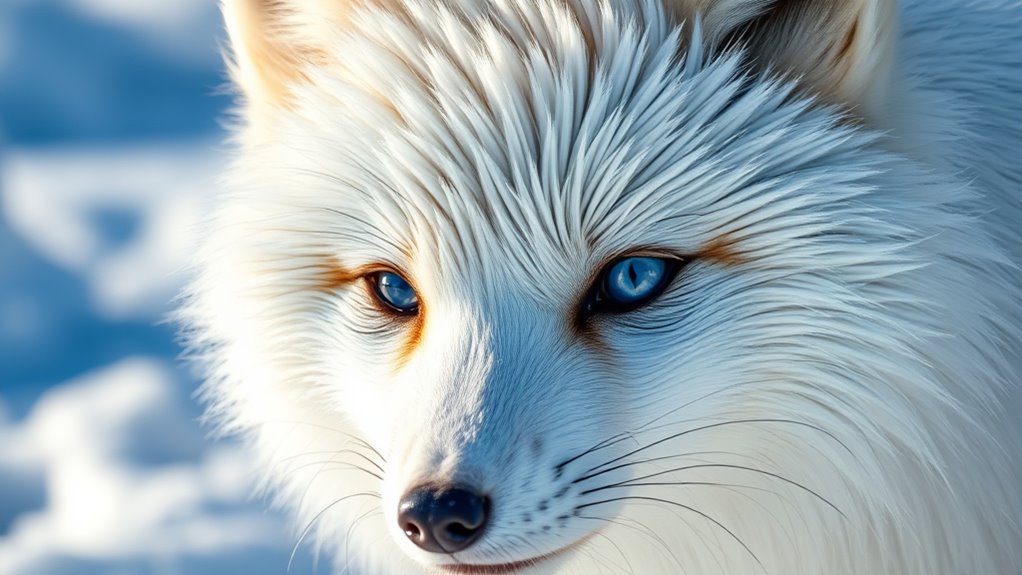
Fur thickness and density are vital factors in how animals maintain their body heat in harsh climates. A thicker fur layer, like that of a polar bear, can effectively insulate against extreme cold, such as -40°C (-40°F).
Denser fur traps more air, creating a significant layer of air that acts as an insulator, reducing heat transfer and stabilizing body temperature. Notably, a five-centimeter layer of still air can provide insulation similar to that of dense fur, showcasing the importance of air retention.
Additionally, the structure of the fur, including individual hairs and barbs, enhances heat retention through mechanisms like backscattering of infrared light, further improving thermal regulation in various species.
Evolutionary Adaptations for Thermal Regulation
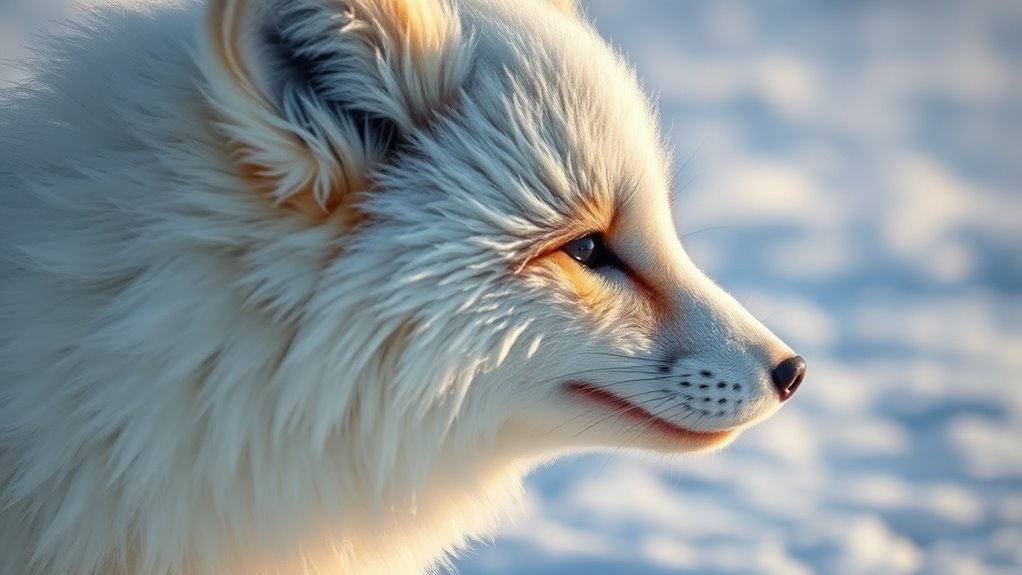
As climates have changed over millions of years, many mammals have adapted their fur to better regulate their body temperature in response to environmental challenges.
For instance, species like polar bears and arctic foxes have evolved thick fur, allowing them to maintain stable body temperatures in frigid conditions. This insulating effectiveness comes from fur's ability to trap large amounts of air, which acts as a poor conductor of heat, reducing heat loss.
Some mammals, such as seals and whales, have also developed blubber for additional insulation. The variations in fur density and structure optimize thermal regulation for specific habitats, ensuring survival.
These evolutionary adaptations not only aid in temperature control but also impact metabolic rates and overall health.
Frequently Asked Questions
How Does Fur Insulate Animals?
Fur insulates animals by trapping air within its fibers, creating a barrier against heat loss.
When you touch fur, you'll notice it feels warm because it retains body heat. The thickness and density of the fur vary across species, enhancing its insulating ability.
Some animals even have specialized structures that scatter infrared light, reducing radiation heat loss. This effective insulation helps maintain a stable body temperature, essential for survival in cold environments.
Why Is Animal Fur a Good Insulator?
Imagine wrapping yourself in a cozy blanket on a chilly night. That's what animal fur does!
It's a great insulator because it traps layers of still air, which keeps heat from escaping. Plus, fur scatters infrared light, helping maintain body temperature even in extreme cold.
With its unique structure, fur reflects heat effectively, making it far superior to many man-made materials.
What Is the Function of Fur on Animals?
Fur on animals serves several essential functions. It provides warmth and protects against harsh weather conditions.
You'll notice that it also helps in camouflage, allowing animals to blend into their surroundings for safety. Additionally, fur can aid in sensory perception, with specialized hairs detecting changes in the environment.
It also plays a role in social interactions, as different fur patterns can signal health and readiness for mating. Overall, fur is crucial for survival in their habitats.
Does Fur Help Keep Animals Warm?
Imagine wrapping yourself in a cozy blanket on a frosty morning. That's what fur does for animals—it keeps 'em warm!
Yes, fur helps maintain body temperature by trapping air, which acts like a natural insulator. For creatures in frigid climates, thick fur shields them from the chill, while also reflecting heat.
Conclusion
In the grand tapestry of nature, fur serves as a cozy cloak, embracing animals with warmth in the chill of their environments. As you've seen, the intricate mechanisms of heat retention and the diverse adaptations across species reveal a masterful design. With each strand of fur, these creatures weave a shield against the cold, showcasing the beauty of evolution's handiwork. So, next time you admire an animal's fur, remember its silent promise of warmth and survival.
